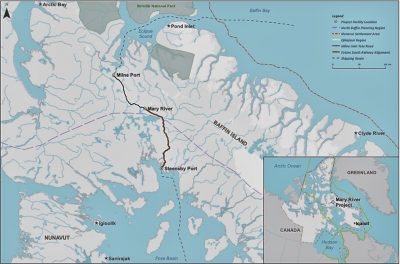CEO Brian Penney unveils future of Mary River iron mine at Northern Lights keynote speech
Baffinland Iron Mines Corp. plans to begin work on its Steensby Inlet rail project by the end of the year, if it can secure the funds.
CEO Brian Penney made the announcement Thursday morning during a keynote speech on the future of Mary River mine at the Northern Lights conference and trade show in Ottawa.
“We are keenly focused on the railway,” he told his audience of government officials, Inuit leaders and northern industry workers.
The Mary River iron mine is located on north Baffin Island in Nunavut.

A map shows Baffinland Iron Mines Corp.’s Mary River mine in relation to Steensby Inlet, where it plans to begin building a railroad for shipping. Also noted on the map is Milne Inlet, where the company had previously hoped to ship through. (Graphic courtesy of Baffinland Iron Mines Corp.)
Baffinland spent the past five years focused on a proposal to double its output of iron ore from the mine to nearby Milne Inlet. The federal government rejected that proposal in November.
In 2012, the federal government approved Baffinland’s proposal to build a railroad south from the mine to Steensby Inlet. A month later, the company announced it was going to focus on shipping its ore from Milne Inlet instead.
At the time, the company cited funding issues for turning away from Steensby Inlet. A decade later, Penney said the company is still trying to overcome that barrier.
“Steensby is over five times more expensive than the northern railway, and financial institutions at that time were just not prepared to give the backing needed to build it,” Penney said during his speech.
Now, he said, the Mary River deposit has proven to hold enough high-grade iron ore to make such an investment worthwhile.
Baffinland’s leaders have long said that they had not fully abandoned their railway project. As recently as 2021, they were still saying its Steensby plan was still on the table.
Aside from financing, the next steps for getting Steensby off the ground involve talking to communities and securing necessary approvals, said Penney.
Penney was not available for an interview after the announcement to expand on his company’s plans.
Nunavut Premier P.J. Akeeagok was in the audience for Penney’s speech. He said the announcement was news to him, but he would have an open mind as communities and regional organizations are consulted.
“Once we’ve seen the proposal, I’m sure we’ll have the opportunity to really assess it,” he said.
“We’ve been very clear that we’re open, willing to sit down with QIA, with NTI, with Baffinland, with Agnico, really with anybody.”
In a statement emailed to Nunatsiaq News later Thursday, federal Northern Affairs Minister Daniel Vandal said, “The southern route through Steensby Inlet has previously received approval and we are encouraged by Baffinland’s continued engagement with local communities and Inuit partners.
“Our office will continue to work with all partners to protect jobs and grow the economy, while ensuring Inuit rights are respected.”
Penney also used his speech to reflect on the past year at Baffinland and reiterated the disappointment he felt when the federal government rejected the Mary River Phase 2 expansion.
“It would be easy to only see the negative at the end of a half decade of consultations and regulatory undertaking,” he said.
“Instead, I am choosing to look ahead with a positive perspective.”
Penney highlighted Baffinland’s hiring of 71 new Inuit employees, bringing the total to 350.
He also emphasized that Nunavut is set to play a role in the global transition to a green, renewable economy.
“The future has never been brighter for Mary River Mine,” Penney said.
“The world needs Nunavut’s high-grade iron ore.”